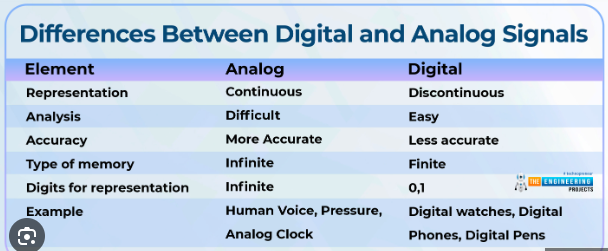Difference between Analog and digital signal
There is a key difference between analog and digital signals. An analog signal is a signal generated by an

What is an Analog signal?
The analog signal is that generated by electromagnetism and is represented by a continuous mathematical function with variables such as amplitude and period as information data as a function of time. Certain physical quantities that carry an analog signal are electrical signals such as voltage, power, and intensity, as well as signals such as pressure, temperature, sound, energy, and light.
These types of signals are susceptible to being modified by noise, that is, any variation in the information. Information is difficult to retrieve and this loss affects the correct operation and performance of a device.
What is a Digital signal?
It is a type of signal in which each sign is coded in the same way and can be analyzed in terms of magnitudes that represent discrete values and are not located within a range.
Systems that use digital signals use the logic of two states represented by two levels of electrical voltage, one high and one low. These states are replaced by zeros and ones, facilitating the application of logic and binary arithmetic.
These types of signals can be amplified and reconstructed, they can also be easily corrected and processed. They can be generated infinitely with minimal quality losses. They may require prior analog-digital conversion and decoding during the reception.
suggested video:
Analog signal vs Digital Signal
Difference between Analog and Digital Signal in points
- The digital signal uses two states to represent discrete values.
- Analog signals are generated by electromagnetism and can be represented by variables of amplitude and period based on time.
- Digital signals are less affected by ambient noise.
- Analog signals are seriously affected by noise and there is more interference in the signal.
Recent Posts
Is energy quantized in classical physics?
No, according to classical wave theory the emission of electromagnetic radiations from the surface is…
Types of laser
Basically, there are four types of laser which includes: Gas Lasers Solid State lasers Liquid…
Ultrasound frequency range
What is ultrasonics? The study and application of mechanical vibrations with frequencies beyond the limits…
Electromagnetic Energy: What are some examples of it?
Electromagnetic energy definition Electromagnetic energy is the amount of energy stored in a region of…
Fundamental units and Derived Units with Examples
The Main Difference between fundamental Units and Base units is that Units that Express base…
Newton’s First law of Motion Examples in Our Daily Life
Newton's first law of motion states that " A body continues its state of rest…